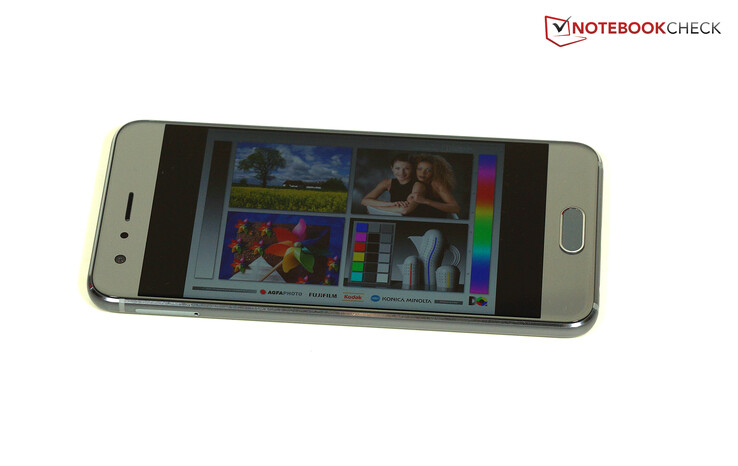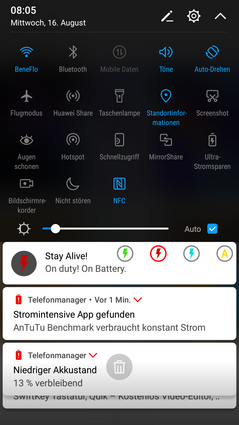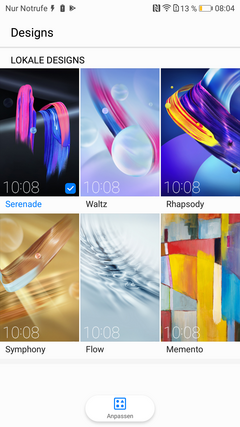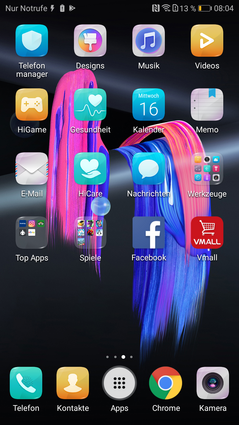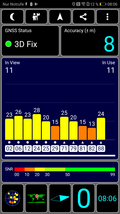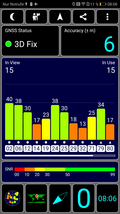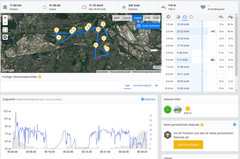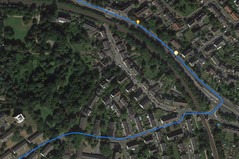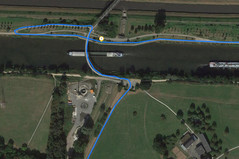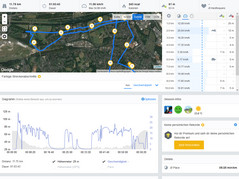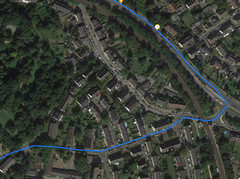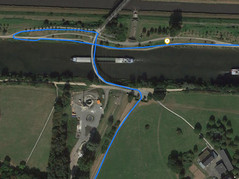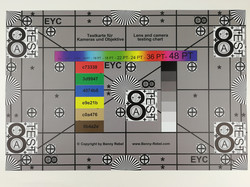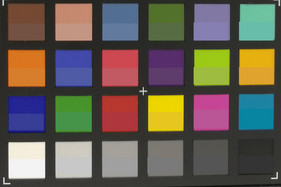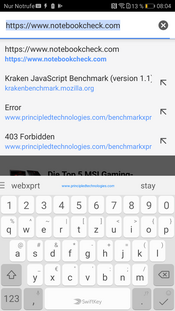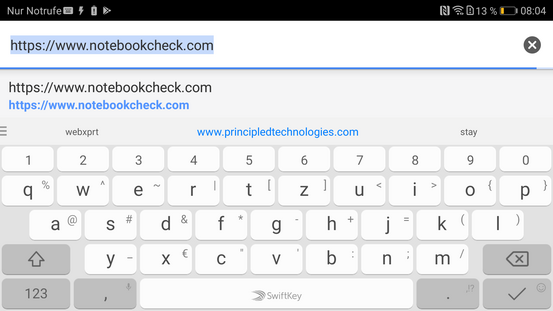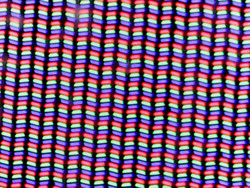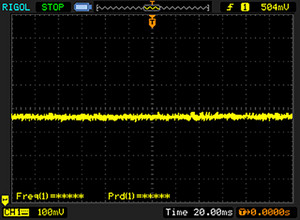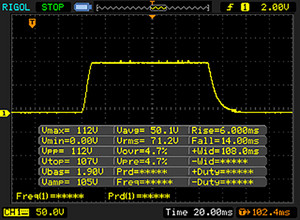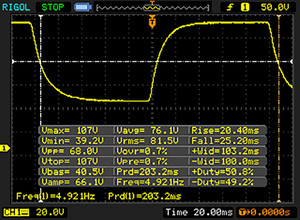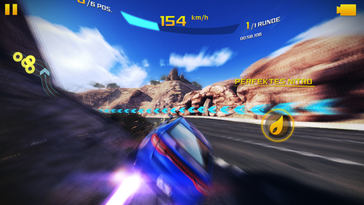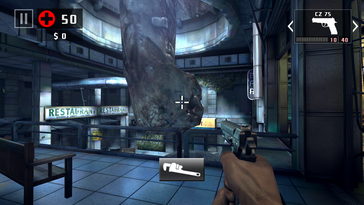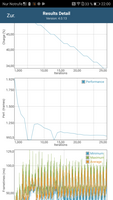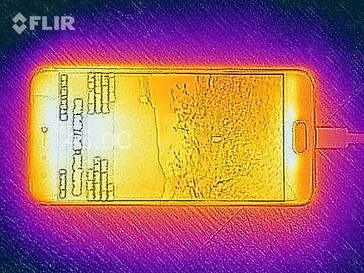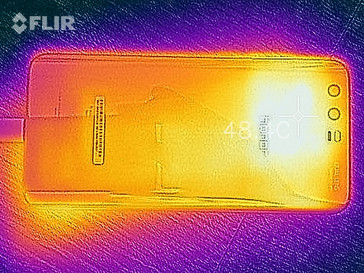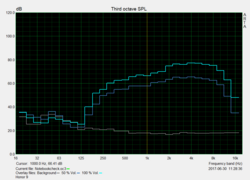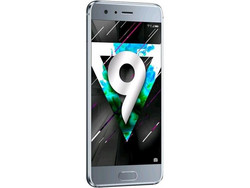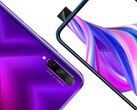Honor 9 Smartphone Review
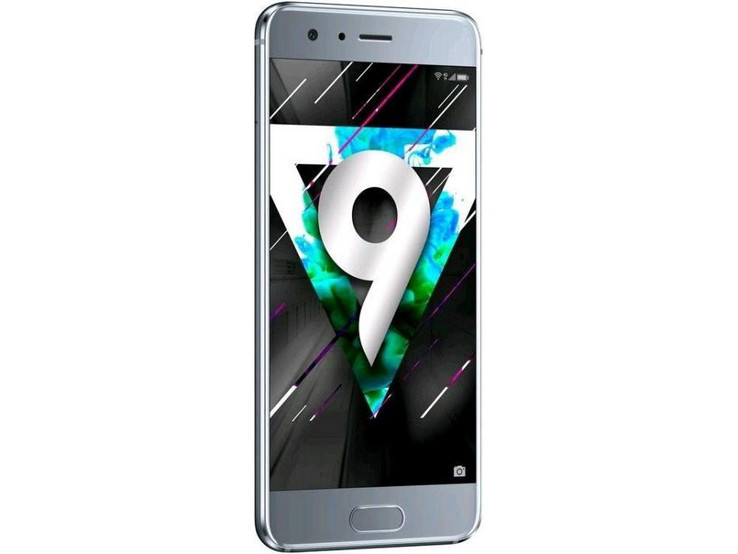
For the original German review, see here.
Last year we acknowledged that the Honor 8 had qualities of a real killer flagship. However, one flagship in particular had to watch out: the Huawei P9 from the same manufacturer, which offered very similar qualities in many respects, but was 100 Euros (~$118) more expensive than the Honor 8. How did Shirley Bassey say it in her song? "It's all just a little bit of history repeating." And so this year once again, the story repeats itself. The Huawei P10 appears and is compelling in the test, and then the direct-sales subsidiary company Honor brings the Honor 9 to the market, offering a model with similar features that is clearly more affordable by more than 100 Euros (469 Euros/~$553 recommended price, but currently the manufacturer itself sells it for 429 Euros/~$506; around $470 in the US). The SoC is similar and the display resolution, battery capacity, and according to the specifications the dual cameras appear suspiciously similar. However, the Honor camera has to make do without the Leica branding.
Does the Honor 9 come even closer to the Huawei P10 this year? We will out in the test and in addition will compare it with last year's predecessor, the Honor 8, which you can currently purchase from the Internet for less than 300 Euros (~$354). The Sony Xperia XZ and Asus ZenFone 3 are additional comparison devices, as well as the OnePlus 5, which can also only be purchased via direct sales.
Update 11/28/2017: new firmware B150 released. Details can be found in the Software section.
Case
Compared to the Honor 8, there are only detail changes in the case. The fingerprint sensor has moved from the back to the front below the screen, and the back is now rounded at the edges, which is pleasing to the eyes and also improves the handling. The Honor 9 fits well into the hand and with just 2 grams extra, has the same weight as the predecessor, but is slightly heavier than the Huawei P10. The color variations are the same as the predecessor: black or blue, and according to the manufacturer, the silver-gray is a new color. The design highlight in all colors variants is again the back, which distributes light reflections around the back. The small bezels on the front continue to please.
The battery remains built-in and the device cannot be opened. The case is once again very stable and can only be twisted minimally, if at all, making a slight audible creak. Pressure on the back does not reach the liquid crystal in the front, but strong pressure on the front becomes visible as waves on the screen.
Features
The storage equipment is sized similarly to the Huawei P10. The standard version of the Honor 9 has 4 GB of working memory and 64 GB of storage. Supposedly, for about 50 Euros (~$59) extra, there will be a premium variant with 6 GB of RAM and 128 GB storage. However, the 64 GB ROM in our test unit were only eMMC flash, and not fast UFS-2.1 storage as in the Huawei P10, even though for a long time it was a matter of luck which kind of storage you would receive.
The Honor 9 handles two SIM cards. However, you will need to decide between the second SIM card and a microSD card of up to 128 GB, since both cards use the same slot. Although the microSD card can only be formatted as external storage, you can still move apps to the SD card.
The USB-C port at the bottom now also supports USB-OTG, but it can still only communicate at USB-2.0 speeds.
Software
On the Honor 9, Android 7.0 is installed and overlaid by Huawei's EMUI 5.1 surface. During our testing, there was an update which installed the security patches from July 5, 2017. This makes the patches relatively current at the time of testing. Huawei adds a global search, which extends over the whole device, including the settings, files, and data and online content, so that only one search screen is needed. Machine learning is also supposed to improve the storage utilization and make scrolling more smooth. You can display an automatic slide show in the Gallery app or search the photos for a particular person.
Unfortunately, Huawei has also pre-installed many additional and advertising apps, such as games or the app of a large travel portal. Anyone not wanting these apps will be busy for a while, uninstalling them. Among the useful tools are the Phone Manager, which can perform a virus scan and clean the storage, a separate app for applying various designs, and HiGame, an additional shop for new mobile games. Huawei's own VMall online shop is also linked to an app.
Update 11/28/2018: Honor has released firmware STF-L09C432B150 (3.13 GB) with user interface optimizations as well as support for VoLTE (Voice over LTE) and VoWifi (Voice over Wifi), assuming respective support by the network operator. Google’s security patches have been updated to 08/05/2017, and the new firmware comes with the Quik app as well as a video editor by GoPro preinstalled. Both can be uninstalled if necessary.
Communication and GPS
The featured LTE bands show a first clear difference to the Huawei P10. While Huawei's flagship shines with the support of a multitude of LTE bands, the Honor 9 shows itself as more conservative. The European version supports merely six LTE bands, so you should not go too far from the European continent, if you still want to use the LTE net. Similarly priced smartphones such as the OnePlus 5 are more compelling with 19 LTE frequencies. There are conflicting reports on the speeds on the Internet, and there are no official specifications by the manufacturer. Upon our request, Honor tells us that the smartphone receives data at 300 MBit/s and sends at up to 50 MBit/s. This corresponds to LTE Cat. 6 and is considerably slower than the Huawei P10 with LTE Cat. 12. In the well-developed German D2 net, we also had a decent reception indoors. At least half the signal strength was available most of the time.
All the usual current WLAN standards are supported, which includes the fast 802.11 ac networks and the 5 GHz band. The speeds are slower than the Huawei P10, and during sending they were even reminiscent of the P10 speeds before Huawei applied a patch that increased the speed considerably. Even though the Honor 9 also does not reach the speeds of the very fast OnePlus 5 overall, the WLAN speeds are okay by and large. We also check the reception and site rendering speeds near and at 10 meters (~33 ft) away from the router in our practice test. Near the router, the reception is fully there and the sites are also rendered quite fast. Further away from the router and separated by three walls, both values remain the same – perfect.
| Networking | |
| iperf3 transmit AX12 | |
| OnePlus 5 | |
| Huawei P10 | |
| Honor 9 | |
| Asus Zenfone 3 ZE552KL | |
| iperf3 receive AX12 | |
| OnePlus 5 | |
| Huawei P10 | |
| Honor 9 | |
| Asus Zenfone 3 ZE552KL | |
Even indoors, the GPS module locates us quickly down to an accuracy of 8 meters (~26 ft). Outdoors it is still slightly more accurate at up to 6 meters (~20 ft). That is an average value.
Now we look how accurately the smartphone can trace our route with its GPS module. We pack the Honor 9 into our backpack, also taking the Garmin Edge 500 professional navigation device, and take our mountain bike for a spin. After 11.8 km (~7.3 miles), our trip ends and we check how both devices have measured: the route measured by the Honor 9 is 90 meters (295 ft) shorter. Over a distance of 11 kilometers, this is a deviation that is not too high. You have to look for the detail differences with a magnifier: from time to time the Honor 9 measurements are slightly less exact and it draws a straight line where the Garmin Edge 500 displays the route more accurately. However, this is only the case in some specific, very short sections of the path. Elsewhere the accuracy is really good for a smartphone. Thus, the Honor 9 can be used for navigation purposes without a second thought.
Telephone and Call Quality
Huawei has adjusted the Phone app slightly compared to Google's original, but all in all the operation is very similar. Contacts and Favorites can be selected via two tabs in the top right section, and at the beginning the list of recent calls and a keypad are displayed.
The voice quality in the Honor 9 cannot really convince us. Even though the earpiece and the speaker are sufficiently loud, there is an audible boom in the earpiece at maximum volume. Moreover, our conversation partner always sounds quite far away and not as clear as we would like. The microphone also records our voice when we speak quietly but booms when we talk too loud. In addition, we come across as slightly muffled and with little presence at our conversation partner's phone.
Cameras
As with its predecessor, there is an 8-Megapixel camera in the front. Given the right distance, the sharpness is decent, but in the detail the color areas do not appear cleanly. The color representation appears quite cool. The quality is sufficient for a quick selfie, but there are better front cameras. If you like, you can activate a Bokeh blurring effect for the background and a Beauty filter which softens skin blemishes for portraits.
At a first glance, there is only little that has changed in the back as well. The dual camera with the 20 MP black-and-white lens and 12 MP color lens that is familiar from the predecessor and also the Huawei P10 and P9 still remains. The combination of phase and laser auto-focus also continues to be present, the same as the dual-LED flash. The software offers all the options that you get in the Huawei P10, such as a mode with blurring effects in the background or a manual mode. There is also a 2x optical zoom, which is made possible by the different focal distances of the two lenses. In addition, the black-and-white sensor collects more information about the image in order to improve the images of the color sensor.
As with the Huawei P10, we like the pictures of the main camera, the image sharpness is compelling; the colors merely appear slightly cool. Even in enlargements the edges fray only minimally, and the dynamic in dark and bright areas are also pleasing. In weak light, the Honor 9 cannot keep up with more expensive smartphones such as the Samsung Galaxy S8+. But the performance is decent and still extracts something from the available light.
Videos can be recorded in 4K quality with the main camera. However, then you will have to forgo the image stabilizer, which only works up to Full HD and 30 FPS. The video function brings good results, colors appear vivid, and the exposure adjusts to the light conditions well and quickly. Anyone who likes to record short videos will be pleased about the cooperation with GoPro. Via a special function, short videos can be recorded when you press the shutter release and can be automatically combined into a longer video later via the appropriate software.
The main camera also has to prove itself under controlled light conditions in the lab. Here, we notice that the image sharpness is reduced slightly towards the edges, while it is very good in the center. Text in front of a colored background is not reproduced completely cleanly, but now we are nit-picking. The color reproduction is slightly spotty and too oversaturated from time to time, but overall, we also like the representation of the main camera very much.
Accessories and Warranty
The box includes a quick charger and a USB cable, and there is also a tool for opening the SIM tray. Currently, you cannot find any special accessories for the Honor 9 in Huawei's VMall.
Honor or Huawei offers a 24-month warranty on the Honor 9, which is another small difference compared to the Huawei P10, where you can extend the warranty to 36 months free of charge. Please see our Guarantees, Return policies and Warranties FAQ for country-specific information.
Input Devices and Operation
The Honor 9 uses SwiftKey as its keyboard app, but you can change to Google's GBoard or install a new keyboard without any trouble. SwiftKey is a very widespread and well-liked keyboard app which you can also download yourself from the Google Play Store. As well as many setting options, it also offers extensive statistics on the past inputs. You can use several languages with the keyboard at the same time, change the size, adjust word predictions, and so forth.
The touchscreen is very pleasant to the touch and can be operated smoothly. It is also very responsive at the edges. There is also an option for a glove mode, which allows you to operate the touchscreen with thin gloves in winter. The navigation keys for the Android system are touch-sensitive areas below the screen, and the fingerprint sensor is used as the Home key. If you like, you can also only use the fingerprint sensor, where a long press activates the Home screen, a short tap goes back one step, and a swipe activates the overview of all the open apps. After a brief familiarization, this works very well, so it is a matter of taste as to which way of navigation you prefer.
If the screen is too big for your hands, you can activate one-handed operation, or you can use movement gestures to take calls by raising the phone to your ear, or mute the phone by turning it over.
Display
Huawei provides the Honor 9 with a Full HD display with the slightly unusual diameter of 5.15 inches, which is 0.05 inches larger than that in the Huawei P10. The screen is based on the LTPS-IPS technology, which is energy saving but also quite expensive. The OnePlus 5 is the only one of the comparison devices that has an AMOLED screen with organic light diodes, which can be completely turned off and manage without a background light.
With an average of 535 cd/m2 the Honor 9 can be quite bright, but the Huawei P10 and Asus ZenFone 3 can shine even brighter. At 92%, the brightness distribution is quite even, so that even large color areas are lit up evenly.
| |||||||||||||||||||||||||
Brightness Distribution: 92 %
Center on Battery: 550 cd/m²
Contrast: 1310:1 (Black: 0.42 cd/m²)
ΔE ColorChecker Calman: 3.3 | ∀{0.5-29.43 Ø4.77}
ΔE Greyscale Calman: 3.6 | ∀{0.09-98 Ø5}
Gamma: 2.38
CCT: 7226 K
| Honor 9 IPS/LTPS, 1920x1080, 5.2" | Sony Xperia XZ IPS, 1920x1080, 5.2" | Huawei P10 LTPS, 1920x1080, 5.1" | OnePlus 5 AMOLED, 1920x1080, 5.5" | Asus Zenfone 3 ZE552KL IPS, 1920x1080, 5.5" | Honor 8 IPS, 1920x1080, 5.2" | Xiaomi Mi 6 IPS, 1920x1080, 5.2" | |
|---|---|---|---|---|---|---|---|
| Screen | -34% | -22% | 12% | -32% | -39% | -8% | |
| Brightness middle (cd/m²) | 550 | 544 -1% | 547 -1% | 426 -23% | 658 20% | 451 -18% | 620 13% |
| Brightness (cd/m²) | 535 | 521 -3% | 556 4% | 431 -19% | 633 18% | 443 -17% | 586 10% |
| Brightness Distribution (%) | 92 | 93 1% | 86 -7% | 93 1% | 93 1% | 93 1% | 89 -3% |
| Black Level * (cd/m²) | 0.42 | 0.37 12% | 0.43 -2% | 0.66 -57% | 0.4 5% | 0.28 33% | |
| Contrast (:1) | 1310 | 1470 12% | 1272 -3% | 997 -24% | 1128 -14% | 2214 69% | |
| Colorchecker dE 2000 * | 3.3 | 5.8 -76% | 4.8 -45% | 1.6 52% | 4.9 -48% | 5.4 -64% | 4.8 -45% |
| Colorchecker dE 2000 max. * | 4.5 | 9.8 -118% | 8.8 -96% | 4.1 9% | 9.1 -102% | 9.9 -120% | 8.8 -96% |
| Greyscale dE 2000 * | 3.6 | 7.2 -100% | 4.5 -25% | 1.7 53% | 5.8 -61% | 6.7 -86% | 5.3 -47% |
| Gamma | 2.38 92% | 2.18 101% | 2.39 92% | 2.25 98% | 2.26 97% | 2.33 94% | 2.25 98% |
| CCT | 7226 90% | 8619 75% | 7194 90% | 6329 103% | 7840 83% | 8262 79% | 7473 87% |
* ... smaller is better
Screen Flickering / PWM (Pulse-Width Modulation)
| Screen flickering / PWM not detected | |||
In comparison: 53 % of all tested devices do not use PWM to dim the display. If PWM was detected, an average of 8081 (minimum: 5 - maximum: 343500) Hz was measured. | |||
The black value of 0.42 cd/m2 is decent, but of course the OnePlus 5 with its AMOLED screen and absolute black value has an advantage here. At 1310:1, the contrast ratio is very good, and colors appear vibrant on the display. The white balance can be manually adjusted with an onscreen slider, but you can also select one of three profiles or activate an eye-saving blue filter.
We are testing the display in more detail with our spectral photometer and the CalMAN software, and for our tests we use the AdobeRGB and sRGB color spaces and the DCI-P3 color space that is used for movie projections. In the Standard setting, we measure a clear blue tint, but it disappears to a large extent through the Warm white balance setting and the color deviations are also considerably less. In the Warm mode, the color space coverage of the DCI-P3 is quite good, and also almost 92% of AdobeRGB are still covered in the Standard mode.
Display Response Times
| ↔ Response Time Black to White | ||
|---|---|---|
| 20 ms ... rise ↗ and fall ↘ combined | ↗ 6 ms rise | |
| ↘ 14 ms fall | ||
| The screen shows good response rates in our tests, but may be too slow for competitive gamers. In comparison, all tested devices range from 0.1 (minimum) to 240 (maximum) ms. » 42 % of all devices are better. This means that the measured response time is similar to the average of all tested devices (20.2 ms). | ||
| ↔ Response Time 50% Grey to 80% Grey | ||
| 45.6 ms ... rise ↗ and fall ↘ combined | ↗ 20.4 ms rise | |
| ↘ 25.2 ms fall | ||
| The screen shows slow response rates in our tests and will be unsatisfactory for gamers. In comparison, all tested devices range from 0.165 (minimum) to 636 (maximum) ms. » 77 % of all devices are better. This means that the measured response time is worse than the average of all tested devices (31.6 ms). | ||
For outdoor use, the brightness sensor can be made more sensitive via the settings, which can make the brightness slightly brighter when it detects bright sunlight. In general, due to the very bright display, outdoor usage is easily possible.
If you tilt the smartphone, the image becomes slightly darker, but in general the viewing angles are good from any angle.
Performance
As with the Huawei P10, the Honor 9 also uses a HiSilicon Kirin 960 SoC, developed by Huawei. It has 8 cores and a maximum clock speed of 2400 MHz. With that, the Honor 9 is on the same high performance level as the P10, and the Honor 8 predecessor is in parts clearly surpassed. Apparently, the OnePlus 5 can pull ahead, but you should also bear in mind that OnePlus has optimized its smartphone here for many benchmarks, so that the results do not necessarily speak about everyday usage.
In terms of graphics unit, an ARM Mali-G71 MP8 is used. It also has 8 cores and a maximum clock speed of 900 MHz. In graphics intensive benchmarks, the Honor 9 is capable of a similar performance as the Huawei P10, and with that it can keep up with many current smartphones of the high-end.
| AnTuTu v6 - Total Score (sort by value) | |
| Honor 9 | |
| Sony Xperia XZ | |
| Huawei P10 | |
| OnePlus 5 | |
| Asus Zenfone 3 ZE552KL | |
| Honor 8 | |
| PCMark for Android | |
| Work performance score (sort by value) | |
| Honor 9 | |
| Sony Xperia XZ | |
| Huawei P10 | |
| OnePlus 5 | |
| Asus Zenfone 3 ZE552KL | |
| Honor 8 | |
| Work 2.0 performance score (sort by value) | |
| Honor 9 | |
| Sony Xperia XZ | |
| Huawei P10 | |
| OnePlus 5 | |
| Geekbench 4.4 | |
| 64 Bit Single-Core Score (sort by value) | |
| Honor 9 | |
| Huawei P10 | |
| OnePlus 5 | |
| 64 Bit Multi-Core Score (sort by value) | |
| Honor 9 | |
| Huawei P10 | |
| OnePlus 5 | |
| GFXBench (DX / GLBenchmark) 2.7 | |
| T-Rex Onscreen (sort by value) | |
| Honor 9 | |
| Sony Xperia XZ | |
| Huawei P10 | |
| OnePlus 5 | |
| Asus Zenfone 3 ZE552KL | |
| Honor 8 | |
| 1920x1080 T-Rex Offscreen (sort by value) | |
| Honor 9 | |
| Sony Xperia XZ | |
| Huawei P10 | |
| OnePlus 5 | |
| Asus Zenfone 3 ZE552KL | |
| Honor 8 | |
| GFXBench 3.0 | |
| on screen Manhattan Onscreen OGL (sort by value) | |
| Honor 9 | |
| Sony Xperia XZ | |
| Huawei P10 | |
| OnePlus 5 | |
| Asus Zenfone 3 ZE552KL | |
| Honor 8 | |
| 1920x1080 1080p Manhattan Offscreen (sort by value) | |
| Honor 9 | |
| Sony Xperia XZ | |
| Huawei P10 | |
| OnePlus 5 | |
| Asus Zenfone 3 ZE552KL | |
| Honor 8 | |
| GFXBench 3.1 | |
| on screen Manhattan ES 3.1 Onscreen (sort by value) | |
| Honor 9 | |
| Sony Xperia XZ | |
| Huawei P10 | |
| OnePlus 5 | |
| Asus Zenfone 3 ZE552KL | |
| Honor 8 | |
| 1920x1080 Manhattan ES 3.1 Offscreen (sort by value) | |
| Honor 9 | |
| Sony Xperia XZ | |
| Huawei P10 | |
| OnePlus 5 | |
| Asus Zenfone 3 ZE552KL | |
| Honor 8 | |
| GFXBench | |
| on screen Car Chase Onscreen (sort by value) | |
| Honor 9 | |
| Sony Xperia XZ | |
| Huawei P10 | |
| OnePlus 5 | |
| Asus Zenfone 3 ZE552KL | |
| Honor 8 | |
| 1920x1080 Car Chase Offscreen (sort by value) | |
| Honor 9 | |
| Sony Xperia XZ | |
| Huawei P10 | |
| OnePlus 5 | |
| Asus Zenfone 3 ZE552KL | |
| Honor 8 | |
However, while surfing on the Internet, the Honor 9 is slightly slower than the Huawei P10 and also slightly slower than the Honor 8 predecessor. At the same time, it is considerably faster than a mid-range smartphone such as the Asus ZenFone 3. Demanding HTML5 games such as those at letsplay.ouigo.com do not need long to load and then also run quite smoothly.
| JetStream 1.1 - Total Score | |
| OnePlus 5 | |
| Honor 8 | |
| Honor 9 | |
| Huawei P10 | |
| Sony Xperia XZ | |
| Asus Zenfone 3 ZE552KL | |
| Octane V2 - Total Score | |
| OnePlus 5 | |
| Honor 8 | |
| Huawei P10 | |
| Honor 9 | |
| Sony Xperia XZ | |
| Asus Zenfone 3 ZE552KL | |
| Mozilla Kraken 1.1 - Total | |
| Asus Zenfone 3 ZE552KL | |
| Honor 9 | |
| Huawei P10 | |
| Honor 8 | |
| Sony Xperia XZ | |
| OnePlus 5 | |
| WebXPRT 2015 - Overall | |
| OnePlus 5 | |
| Honor 8 | |
| Huawei P10 | |
| Honor 9 | |
| Sony Xperia XZ | |
| Asus Zenfone 3 ZE552KL | |
* ... smaller is better
We test the read and write speed of the microSD reader in the Honor 9 with a Toshiba microSD card, the Exceria Pro M501, which has very high maximum transfer rates. The result is okay and even slightly faster than in the Huawei P10, but the card would even allow for considerably faster access rates.
During access of the internal storage, the difference to the Huawei P10 which has the fast UFS-2.1 storage becomes quickly apparent. Huawei's flagship can read and write data considerably faster. Yet the Honor 9 with an eMMC flash is still above the level of its predecessor and reads data fairly quickly. Overall, the loading times are not too long.
| Honor 9 | Sony Xperia XZ | Huawei P10 | OnePlus 5 | Asus Zenfone 3 ZE552KL | Honor 8 | |
|---|---|---|---|---|---|---|
| AndroBench 3-5 | -24% | 114% | 67% | 1% | -26% | |
| Sequential Read 256KB (MB/s) | 293 | 281 -4% | 738 152% | 748 155% | 282 -4% | 247.5 -16% |
| Sequential Write 256KB (MB/s) | 204 | 138 -32% | 189.8 -7% | 201.5 -1% | 188 -8% | 119.3 -42% |
| Random Read 4KB (MB/s) | 55.7 | 71.5 28% | 168.4 202% | 141 153% | 74 33% | 34.16 -39% |
| Random Write 4KB (MB/s) | 32.7 | 10.5 -68% | 152.3 366% | 19.3 -41% | 7.4 -77% | 31.5 -4% |
| Sequential Read 256KB SDCard (MB/s) | 68 | 33.5 -51% | 54.2 -20% | 79.2 16% | 53.7 -21% | |
| Sequential Write 256KB SDCard (MB/s) | 34.64 | 29.8 -14% | 32.19 -7% | 50.1 45% | 23.59 -32% |
Games
At this point we would not want to 100% affirm that the Honor 9 is a real games smartphone, since in "Asphalt 8: Airborne" it only achieves frame rates of 29 FPS, even in very low detail settings. On the other hand, in "Dead Trigger 2" it achieves 45 FPS on average. So it probably depends on the game, whether you can play smoothly or not. Of course simpler games such as "Angry Birds" run without any stutters, as you can expect from a smartphone of this price range.
Operation via position sensor and touchscreen works without a hitch.
| Asphalt 8: Airborne | |||
| Settings | Value | ||
| high | 29 fps | ||
| very low | 29 fps | ||
| Dead Trigger 2 | |||
| Settings | Value | ||
| high | 45 fps | ||
Emissions
Temperature
At 36.9 °C (~98 °F) already in idle mode, we can detect a slight warming in the area of the fingerprint sensor. The back remains cooler. However, under load noticeably higher temperatures are reached: up to 45.4 °C (~114 °F) on the back during the maximum. In summer, this can become uncomfortable if you put the smartphone into your pant pocket.
Can the SoC maintain its performance even during prolonged load? We test this with the GFXBench-Manhattan battery test. In fact, the initial good calculated frame rates drop significantly to about half the performance. There, they remain there with a continued slight downward trend. Thus, anyone who puts high loads for prolonged periods on the Honor 9 should not count on the full performance.
(±) The maximum temperature on the upper side is 45 °C / 113 F, compared to the average of 35.2 °C / 95 F, ranging from 21.9 to 247 °C for the class Smartphone.
(-) The bottom heats up to a maximum of 45.4 °C / 114 F, compared to the average of 34 °C / 93 F
(±) In idle usage, the average temperature for the upper side is 34.1 °C / 93 F, compared to the device average of 32.9 °C / 91 F.
Speakers
In terms of sound, Honor has made quite an effort cooperating with the Monster headphones manufacturer and inviting the Grammy winner Rainer Maillard who produced many classical recordings to optimize the sound. The Huawei Histen technology bundles all the setting options such as the equalizer and also adds an option for 3D sound. However, all this is only valid if you connect a headphone or speaker to the smartphone via a cable. There are no setting options for the internal speaker included.
The small mono speaker on the bottom edge has improved slightly in comparison to the predecessor as our test with the ARTA software shows. There are clearly more low mids and the sound reproduction is linear in general. The speaker is also slightly louder. And indeed you can listen to a piece of music at times, the sound is well mixed, not emphasizing the highs too much, and does not boom even at maximum volume.
But now we would like to see how all the improvements benefit the sound of the headphones. You can either select the 3D sound or use the equalizer, and there are profile presets for various headphone types, but unfortunately not for speakers. The sound output is good and very warm. It is hard to see whether all the cooperating is more than an advertising stunt, but at least the 3.5-mm audio output produces clear sound that is not distorted. The audio signal is also output cleanly via Bluetooth.
Honor 9 audio analysis
(+) | speakers can play relatively loud (85.3 dB)
Bass 100 - 315 Hz
(-) | nearly no bass - on average 23.2% lower than median
(±) | linearity of bass is average (12.9% delta to prev. frequency)
Mids 400 - 2000 Hz
(+) | balanced mids - only 2.9% away from median
(+) | mids are linear (4% delta to prev. frequency)
Highs 2 - 16 kHz
(±) | higher highs - on average 9.1% higher than median
(+) | highs are linear (3% delta to prev. frequency)
Overall 100 - 16.000 Hz
(±) | linearity of overall sound is average (22.3% difference to median)
Compared to same class
» 47% of all tested devices in this class were better, 7% similar, 46% worse
» The best had a delta of 11%, average was 35%, worst was 134%
Compared to all devices tested
» 64% of all tested devices were better, 6% similar, 30% worse
» The best had a delta of 4%, average was 24%, worst was 134%
Honor 8 audio analysis
(+) | speakers can play relatively loud (84.7 dB)
Bass 100 - 315 Hz
(-) | nearly no bass - on average 24% lower than median
(±) | linearity of bass is average (12.1% delta to prev. frequency)
Mids 400 - 2000 Hz
(+) | balanced mids - only 4.1% away from median
(+) | mids are linear (5.3% delta to prev. frequency)
Highs 2 - 16 kHz
(±) | higher highs - on average 11.8% higher than median
(±) | linearity of highs is average (7.2% delta to prev. frequency)
Overall 100 - 16.000 Hz
(±) | linearity of overall sound is average (28% difference to median)
Compared to same class
» 73% of all tested devices in this class were better, 5% similar, 23% worse
» The best had a delta of 11%, average was 35%, worst was 134%
Compared to all devices tested
» 85% of all tested devices were better, 3% similar, 13% worse
» The best had a delta of 4%, average was 24%, worst was 134%
Frequency comparison (Checkboxes selectable!)
Energy Management
Power Consumption
Overall, the power consumption is a bit higher than in the predecessor and slightly lower than in the Huawei P10. Under load in particular, the Honor 9 uses considerably less power than Huawei's flagship. The OnePlus 5 is also slightly more power hungry under load, but uses less power than our test unit in idle mode. Perhaps Huawei could have optimized the overall power consumption of the Honor 9 even a little more. However, it achieves values typical for its class and is quite efficient, particularly under load, but then throttles the performance after a short time, as we saw before.
| Off / Standby | |
| Idle | |
| Load |
|
Key:
min: | |
| Honor 9 3200 mAh | Sony Xperia XZ 2900 mAh | Huawei P10 3200 mAh | OnePlus 5 3300 mAh | Asus Zenfone 3 ZE552KL 3000 mAh | Honor 8 3000 mAh | |
|---|---|---|---|---|---|---|
| Power Consumption | -51% | -2% | 12% | 21% | 17% | |
| Idle Minimum * (Watt) | 1.13 | 1.76 -56% | 0.83 27% | 0.73 35% | 0.83 27% | 0.78 31% |
| Idle Average * (Watt) | 2.25 | 3.6 -60% | 2.1 7% | 1.44 36% | 2.11 6% | 1.89 16% |
| Idle Maximum * (Watt) | 2.3 | 4.06 -77% | 2.18 5% | 1.5 35% | 2.12 8% | 2.02 12% |
| Load Average * (Watt) | 4.89 | 7 -43% | 6.57 -34% | 6.91 -41% | 3.41 30% | 5.28 -8% |
| Load Maximum * (Watt) | 7.99 | 9.52 -19% | 9.32 -17% | 8.51 -7% | 5.46 32% | 5.44 32% |
* ... smaller is better
Battery Life
Even though the Honor 9 comes with a larger battery which can now offer 3200 mAh or 12.16 Wh of power, the runtimes are only slightly above those of the Honor 8. The Huawei P10 with a similarly powerful battery can clearly move ahead in the WLAN test in particular, where it achieves a runtime that is 87% longer than our test unit. Overall, the Honor 9 remains within the standard of its class and achieves a solid result with 8:36 hours in the WLAN test. During regular usage, you can get through the workday without any problems, and when using it frugally, you can even get through two days. There is also an Ultra-Power-Saving mode, which can significantly prolong the runtime.
Super Charge is also supported and recharges the smartphone completely within a little over an hour.
| Honor 9 3200 mAh | Sony Xperia XZ 2900 mAh | Huawei P10 3200 mAh | OnePlus 5 3300 mAh | Asus Zenfone 3 ZE552KL 3000 mAh | Honor 8 3000 mAh | |
|---|---|---|---|---|---|---|
| Battery runtime | -20% | 16% | 3% | 38% | -3% | |
| Reader / Idle (h) | 23.3 | 18.8 -19% | 25.7 10% | 25.6 10% | 25 7% | 24.8 6% |
| H.264 (h) | 9.4 | 8.4 -11% | 9.7 3% | 10.4 11% | 15.1 61% | 8.8 -6% |
| WiFi v1.3 (h) | 8.6 | 7.3 -15% | 16.1 87% | 8.6 0% | 13.3 55% | 8.3 -3% |
| Load (h) | 4.6 | 3.1 -33% | 2.9 -37% | 4.1 -11% | 5.9 28% | 4.3 -7% |
Pros
Cons
Verdict
Yes, that is life with beautiful daughters: sometimes the mother can become jealous. At least, Huawei does not make it easy for its P10 flagship to stand up against the slightly slimmed down Honor 9. For over 100 Euros less (~$118, depending on the price of the day), you really get a lot for your money with the Honor 9. Even the OnePlus 5 has to watch out.
Compared to the Honor 8, the pretty case has improved again, the performance is at the same level as that of the Huawei P10, and the cameras also take pictures that are almost as good. Only in the fast storage, the battery life, and the multitude and speed of the LTE connections, the Honor 9 remains behind Huawei's flagship. In addition, Huawei offers a 36-month warranty for the P10.
Gorgeous case, good camera, decent battery life – we hardly find any reason for complaint with the Honor 9. If the SoC would not throttle under load, our recommendation would even become more clear, but even as it is, the Honor 9 offers a great price-performance ratio.
You could blame Huawei for not giving more attention to the call quality, since that is mediocre at most. The high case temperatures and the throttling SoC during prolonged loads are annoying. However, other than that, we have to pay tribute to the Honor 9. It is a great offering in the mid-range that those interested should not pass.
For those who want to save, the Honor 8, which basically offers the same camera modules and is not far behind in terms of performance, is a great bargain for about 100 Euros (~$118) less.
Honor 9
- 08/17/2017 v6 (old)
Florian Wimmer


